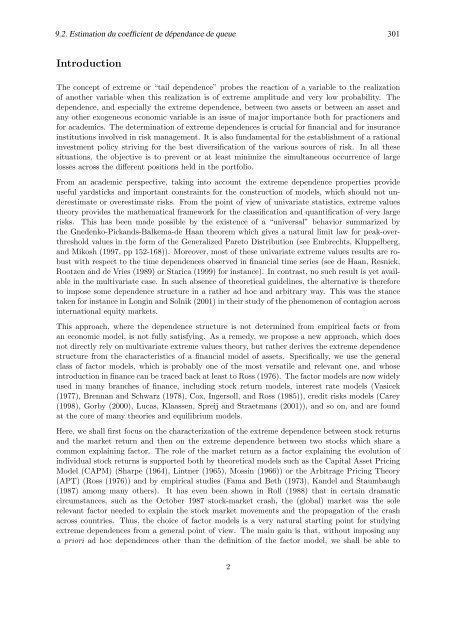statistique, théorie et gestion de portefeuille - Docs at ISFA
statistique, théorie et gestion de portefeuille - Docs at ISFA
statistique, théorie et gestion de portefeuille - Docs at ISFA
You also want an ePaper? Increase the reach of your titles
YUMPU automatically turns print PDFs into web optimized ePapers that Google loves.
9.2. Estim<strong>at</strong>ion du coefficient <strong>de</strong> dépendance <strong>de</strong> queue 301<br />
Introduction<br />
The concept of extreme or “tail <strong>de</strong>pen<strong>de</strong>nce” probes the reaction of a variable to the realiz<strong>at</strong>ion<br />
of another variable when this realiz<strong>at</strong>ion is of extreme amplitu<strong>de</strong> and very low probability. The<br />
<strong>de</strong>pen<strong>de</strong>nce, and especially the extreme <strong>de</strong>pen<strong>de</strong>nce, b<strong>et</strong>ween two ass<strong>et</strong>s or b<strong>et</strong>ween an ass<strong>et</strong> and<br />
any other exogeneous economic variable is an issue of major importance both for practioners and<br />
for aca<strong>de</strong>mics. The d<strong>et</strong>ermin<strong>at</strong>ion of extreme <strong>de</strong>pen<strong>de</strong>nces is crucial for financial and for insurance<br />
institutions involved in risk management. It is also fundamental for the establishment of a r<strong>at</strong>ional<br />
investment policy striving for the best diversific<strong>at</strong>ion of the various sources of risk. In all these<br />
situ<strong>at</strong>ions, the objective is to prevent or <strong>at</strong> least minimize the simultaneous occurrence of large<br />
losses across the different positions held in the portfolio.<br />
From an aca<strong>de</strong>mic perspective, taking into account the extreme <strong>de</strong>pen<strong>de</strong>nce properties provi<strong>de</strong><br />
useful yardsticks and important constraints for the construction of mo<strong>de</strong>ls, which should not un<strong>de</strong>restim<strong>at</strong>e<br />
or overestim<strong>at</strong>e risks. From the point of view of univari<strong>at</strong>e st<strong>at</strong>istics, extreme values<br />
theory provi<strong>de</strong>s the m<strong>at</strong>hem<strong>at</strong>ical framework for the classific<strong>at</strong>ion and quantific<strong>at</strong>ion of very large<br />
risks. This has been ma<strong>de</strong> possible by the existence of a “universal” behavior summarized by<br />
the Gne<strong>de</strong>nko-Pickands-Balkema-<strong>de</strong> Haan theorem which gives a n<strong>at</strong>ural limit law for peak-overthreshold<br />
values in the form of the Generalized Par<strong>et</strong>o Distribution (see Embrechts, Kluppelberg,<br />
and Mikosh (1997, pp 152-168)). Moreover, most of these univari<strong>at</strong>e extreme values results are robust<br />
with respect to the time <strong>de</strong>pen<strong>de</strong>nces observed in financial time series (see <strong>de</strong> Haan, Resnick,<br />
Rootzen and <strong>de</strong> Vries (1989) or Starica (1999) for instance). In contrast, no such result is y<strong>et</strong> available<br />
in the multivari<strong>at</strong>e case. In such absence of theor<strong>et</strong>ical gui<strong>de</strong>lines, the altern<strong>at</strong>ive is therefore<br />
to impose some <strong>de</strong>pen<strong>de</strong>nce structure in a r<strong>at</strong>her ad hoc and arbitrary way. This was the stance<br />
taken for instance in Longin and Solnik (2001) in their study of the phenomenon of contagion across<br />
intern<strong>at</strong>ional equity mark<strong>et</strong>s.<br />
This approach, where the <strong>de</strong>pen<strong>de</strong>nce structure is not d<strong>et</strong>ermined from empirical facts or from<br />
an economic mo<strong>de</strong>l, is not fully s<strong>at</strong>isfying. As a remedy, we propose a new approach, which does<br />
not directly rely on multivari<strong>at</strong>e extreme values theory, but r<strong>at</strong>her <strong>de</strong>rives the extreme <strong>de</strong>pen<strong>de</strong>nce<br />
structure from the characteristics of a financial mo<strong>de</strong>l of ass<strong>et</strong>s. Specifically, we use the general<br />
class of factor mo<strong>de</strong>ls, which is probably one of the most vers<strong>at</strong>ile and relevant one, and whose<br />
introduction in finance can be traced back <strong>at</strong> least to Ross (1976). The factor mo<strong>de</strong>ls are now wi<strong>de</strong>ly<br />
used in many branches of finance, including stock r<strong>et</strong>urn mo<strong>de</strong>ls, interest r<strong>at</strong>e mo<strong>de</strong>ls (Vasicek<br />
(1977), Brennan and Schwarz (1978), Cox, Ingersoll, and Ross (1985)), credit risks mo<strong>de</strong>ls (Carey<br />
(1998), Gorby (2000), Lucas, Klaassen, Spreij and Stra<strong>et</strong>mans (2001)), and so on, and are found<br />
<strong>at</strong> the core of many theories and equilibrium mo<strong>de</strong>ls.<br />
Here, we shall first focus on the characteriz<strong>at</strong>ion of the extreme <strong>de</strong>pen<strong>de</strong>nce b<strong>et</strong>ween stock r<strong>et</strong>urns<br />
and the mark<strong>et</strong> r<strong>et</strong>urn and then on the extreme <strong>de</strong>pen<strong>de</strong>nce b<strong>et</strong>ween two stocks which share a<br />
common explaining factor. The role of the mark<strong>et</strong> r<strong>et</strong>urn as a factor explaining the evolution of<br />
individual stock r<strong>et</strong>urns is supported both by theor<strong>et</strong>ical mo<strong>de</strong>ls such as the Capital Ass<strong>et</strong> Pricing<br />
Mo<strong>de</strong>l (CAPM) (Sharpe (1964), Lintner (1965), Mossin (1966)) or the Arbitrage Pricing Theory<br />
(APT) (Ross (1976)) and by empirical studies (Fama and B<strong>et</strong>h (1973), Kan<strong>de</strong>l and Staumbaugh<br />
(1987) among many others). It has even been shown in Roll (1988) th<strong>at</strong> in certain dram<strong>at</strong>ic<br />
circumstances, such as the October 1987 stock-mark<strong>et</strong> crash, the (global) mark<strong>et</strong> was the sole<br />
relevant factor nee<strong>de</strong>d to explain the stock mark<strong>et</strong> movements and the propag<strong>at</strong>ion of the crash<br />
across countries. Thus, the choice of factor mo<strong>de</strong>ls is a very n<strong>at</strong>ural starting point for studying<br />
extreme <strong>de</strong>pen<strong>de</strong>nces from a general point of view. The main gain is th<strong>at</strong>, without imposing any<br />
a priori ad hoc <strong>de</strong>pen<strong>de</strong>nces other than the <strong>de</strong>finition of the factor mo<strong>de</strong>l, we shall be able to<br />
2




